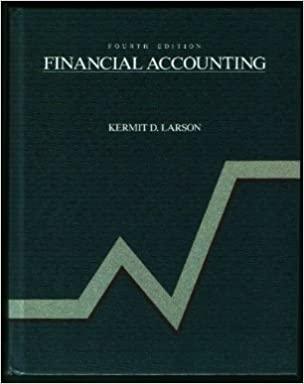On January 1, 2016, Plymouth Corporation acquired 80 percent of the outstanding voting stock of Sander Company in exchange for $1,200,000 cash. At that time,
On January 1, 2016, Plymouth Corporation acquired 80 percent of the outstanding voting stock of Sander Company in exchange for $1,200,000 cash. At that time, although Sanders book value was $925,000, Plymouth assessed Sanders total business fair value at $1,500,000. Since that time, Sander has neither issued nor reacquired any shares of its own stock.
The book values of Sander's individual assets and liabilities approximated their acquisition-date fair values except for the patent account, which was undervalued by $350,000. The undervalued patents had a five-year remaining life at the acquisition date. Any remaining excess fair value was attributed to goodwill. No goodwill impairments have occurred.
Sander regularly sells inventory to Plymouth. Below are details of the intra-entity inventory sales for the past three years:
| Year | Intra-Entity Sales | Intra-Entity Ending Inventory at Transfer Price | Gross Profit Rate on Intra-Entity Inventory Transfers | ||||||
| 2016 | $ | 125,000 | $ | 80,000 | 25 | % | |||
| 2017 | 220,000 | 125,000 | 28 | ||||||
| 2018 | 300,000 | 160,000 | 25 | ||||||
Separate financial statements for these two companies as of December 31, 2018, follow:
| Plymouth | Sander | ||||||
| Revenues | $ | (1,740,000 | ) | $ | (950,000 | ) | |
| Cost of goods sold | 820,000 | 500,000 | |||||
| Depreciation expense | 104,000 | 85,000 | |||||
| Amortization expense | 220,000 | 120,000 | |||||
| Interest expense | 20,000 | 15,000 | |||||
| Equity in earnings of Sander | (124,000 | ) | 0 | ||||
| Net income | $ | (700,000 | ) | $ | (230,000 | ) | |
| Retained earnings 1/1/18 | $ | (2,800,000 | ) | $ | (345,000 | ) | |
| Net income | (700,000 | ) | (230,000 | ) | |||
| Dividends declared | 200,000 | 25,000 | |||||
| Retained earnings 12/31/18 | $ | (3,300,000 | ) | $ | (550,000 | ) | |
| Cash | $ | 535,000 | $ | 115,000 | |||
| Accounts receivable | 575,000 | 215,000 | |||||
| Inventory | 990,000 | 800,000 | |||||
| Investment in Sander | 1,420,000 | 0 | |||||
| Buildings and equipment | 1,025,000 | 863,000 | |||||
| Patents | 950,000 | 107,000 | |||||
| Total assets | $ | 5,495,000 | $ | 2,100,000 | |||
| Accounts payable | $ | (450,000 | ) | $ | (200,000 | ) | |
| Notes payable | (545,000 | ) | (450,000 | ) | |||
| Common stock | (900,000 | ) | (800,000 | ) | |||
| Additional paid-in capital | (300,000 | ) | (100,000 | ) | |||
| Retained earnings 12/31/18 | (3,300,000 | ) | (550,000 | ) | |||
| Total liabilities and stockholders' equity | $ | (5,495,000 | ) | $ | (2,100,000 | ) | |
A. Prepare a schedule that calculates the Equity in Earnings of Sander account balance.
|
B. Prepare a worksheet to arrive at consolidated figures for external reporting purposes. At year end, there are no intra-entity payables or receivables.
| ||||||||||||||||||||||||||||||||||||||||||||||||||||||||||||||||||||||||||||||||||||||||||||||||||||||||||||||||||||||||||||||||||||||||||||||||||||||||||||||||||||||||||||||||||||||||||||||||||||||||||||||||||||||||||||||||||||||||||||||||||||||
Step by Step Solution
There are 3 Steps involved in it
Step: 1

See step-by-step solutions with expert insights and AI powered tools for academic success
Step: 2

Step: 3

Ace Your Homework with AI
Get the answers you need in no time with our AI-driven, step-by-step assistance
Get Started


